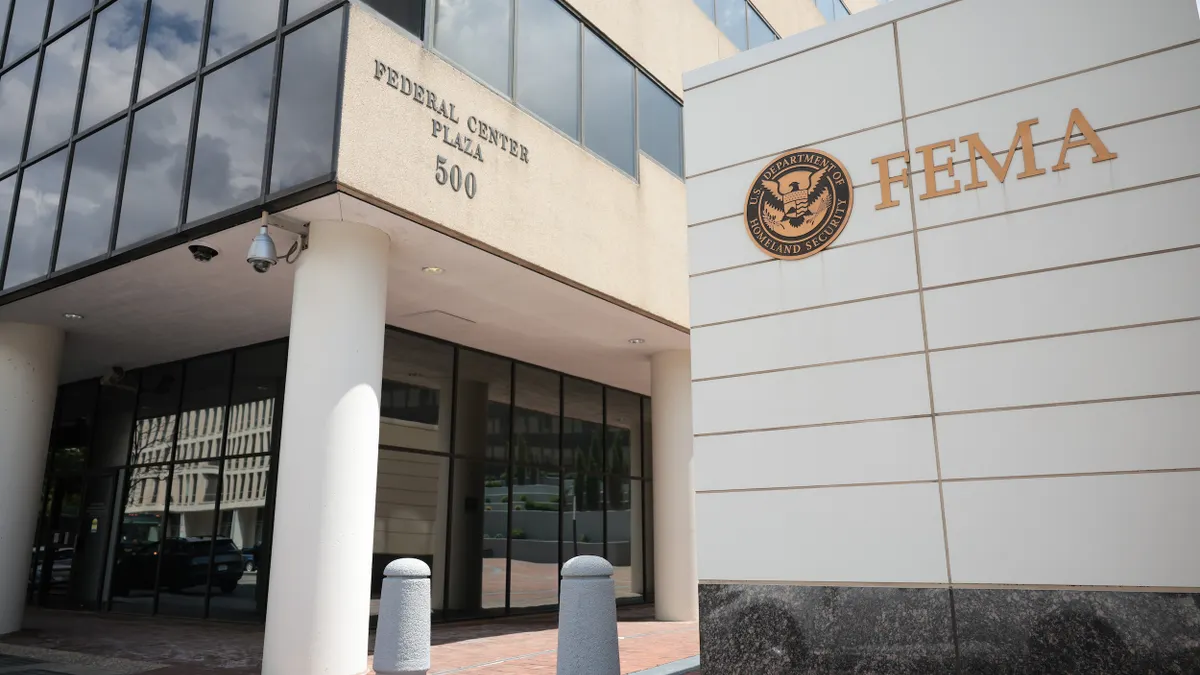Drinking water has long been at the center of city health and environment debates as utilities and public works departments face pressure to keep the basic necessity safe for residents.
That pressure increased last week when the Environmental Working Group (EWG) released a report stating that approximately 110 million Americans are exposed to drinking water with levels of toxic fluorinated chemicals that have long been "dramatically underestimated." The nonprofit’s findings, centered on per- and polyfluoroalkyl substances (PFAS), drummed up headlines highlighting the threat of the "forever chemicals" in major cities.
What many headlines didn’t explain, however, is EWG’s methodology behind the findings. The group sampled 44 places in 31 states and Washington, DC for 30 different PFAS chemicals, and analyzed those samples against a "health-based" standard of contamination of 1 part per trillion (ppt).
This limit is drastically different from the U.S. Environmental Protection Agency’s (EPA) non-enforceable lifetime health advisory limit of 70 ppt, which is applied specifically to the sum of perfluorooctanoic acid (PFOA) and perfluorooctanesulfonic acid (PFOS), two PFAS strains commonly found in drinking water. While this EPA standard is problematic in its own regard due to a lack of aggressive enforcement of such thresholds, it has become the standard that most governments follow in lieu of federal regulations.
The result: Nearly every city sampled had contamination exceeding the EWG limit.
While the report outlined various ways cities can address PFAS contamination, it raised many questions regarding the limits at which they should measure water contamination and the costs of cleaning up such chemicals. Is it possible for cities to purify drinking water to EWG’s standards? If so, how much money and planning will it take to get there?
Understanding varying health advisory limits
PFAS chemicals, particularly PFOA and PFOS, have traditionally been used to make consumer goods including food packaging, carpets or fabrics, and have been prevalent in industrial materials such as firefighting foam. Exposure and disposal of these materials led to contaminated water supplies, which the EPA began to crack down on in 2000.
Following years of research and evidence, the EPA released its most recently updated lifetime health advisory on PFOA and PFOS in 2016, recommending the combined concentrations should not exceed a level of 70 ppt. The EPA said that limit was "based on the best available peer-reviewed studies of the effects of PFOA and PFOS on laboratory animals," and ultimately was "calculated to offer a margin of protection against adverse health effects to the most sensitive populations: fetuses during pregnancy and breastfed infants."
The advisory became the golden standard for most cities, alongside a number of state regulations that have been developed. EWG, however, thinks that limit needs more adjustment.
"The latest science shows decreased vaccine response in children correlated with the amount of PFOA and PFOS in their bodies. There’s mounting research that PFAS other than PFOA and PFOS share the same health harms and risks of toxicity, and there’s building evidence ... that the 1 ppt limit would be protective from cancer and other health harms," Sydney Evans, science analyst at EWG and co-author on the report, told Smart Cities Dive.
Evans explained that lowering the limit to 1 ppt, and including other PFAS strains in recommended testing, would help protect everyone in the long-term, particularly sensitive populations like children and pregnant people. Even at very low levels, and in small concentrations, "[PFAS] still pose a risk over a lifetime."
Those risks include increased cholesterol levels, impaired immune systems and increased risk of cancer, according to the Centers for Disease Control and Prevention’s Agency for Toxic Substances and Disease Registry (CDC/ATSDR). In November 2018, ATSDR developed a set of minimal risk levels (MRLs) to identify how PFAS exposure can impact human health, indicating that children are at-risk if exposed to PFOA levels as low as 21 ppt or PFOS levels as low as 14 ppt.
While the EWG limit takes extra caution to keep populations safe from these harms, some cities have found the 1 ppt expectation to be unrealistic. The Philadelphia Water Department (PWD) described the concentration as "equivalent to a single grain of sand in an Olympic-sized swimming pool."
"[T]he EWG uses health guideline values from a variety of sources including different agency goals and recommendations, some that have never been finalized, to provide a health benchmark for each contaminant," PWD wrote in a statement. Philadelphia came in sixth on the EWG's list at 46.3 ppt.
"[W]e have many concerns with the manner in which their study was conducted and conclusions that were drawn."
Brian Steglitz, water treatment manager for the City of Ann Arbor, MI, echoed these concerns, suggesting that there is not enough research behind the "artificial" number. Ann Arbor, which has a notable history of PFAS mitigation, landed mid-list on EWG's analysis at 15.8 ppt.
"They’re comparing all of these utilities to their own internally set, non-health based standard of 1 ppt," he told Smart Cities Dive. "They have their own agenda and it doesn’t match what anybody in the industry is using as public health goals. And it’s also almost impossible to achieve because we can’t even measure these compounds yet at the levels they’re telling us to shoot for."
The American Water Works Association also threw caution to the EWG findings. Steve Via, director of federal regulations, told Smart Cities Dive their methodology is "markedly different from what the EPA does, and also markedly different from what the states are doing."
Investing in testing and cleanup
While governments and utilities lack clarity around the levels at which PFAS contamination may put the public at risk, there is widespread agreement that more testing and cleanup of the contamination must be done to keep city residents safe.
There is currently no regulated monitoring schedule for testing of PFAS chemicals. However, some states have implemented regular sampling initiatives to better understand their contamination levels. Such testing has helped cities make informed decisions on the best water treatment options.
Aside from simply cutting off contaminated water sources, there are three main treatments that are considered for PFAS mitigation: reverse osmosis, granular activated carbon (GAC) and ion exchange. And each option comes at a cost — both monetarily and environmentally.
Reverse osmosis:
Reverse osmosis is not a new technology, but it requires low energy and results in high recovery by removing nearly all PFAS, according to Evans. Industrial, large-scale systems can cost as much as $2 million to $4 million, and the process wastes water, adding an environmental cost to the option.
"For every gallon of water that’s treated, there are multiple gallons wasted, which is of course a huge issue when you get into broad environmental concerns," Evans said.
Via noted that reverse osmosis can cost a city 15-20% of water supply which then needs to be disposed of due to concentrated levels of PFAS contamination.
"Some communities have looked at re-introducing it to the stream that they took the water from originally, so blending it down to a lower concentration," he said. "Or potentially you’d have a series of treatments that further reduce that waste stream. That comes at a cost consequence, and ultimately it comes with, what do you do with the remaining residuals?"
Granular activated carbon (GAC):
GAC has become a popular water treatment method as it effectively removes PFOA and PFOS, and more data is being collected on its efficiency in treating other PFAS substances, according to Via.
The City of Ann Arbor identified GAC as the best available market-scale technology to meet its treatment needs, and recently piloted various carbon media in filters to see which was most effective for PFAS removal. Once it identified a media and received approval and support from the city council, the water treatment department spent nearly $1 million to replace all the filters in the system, according to Steglitz.
He warned that while the system is effective, it requires costly maintenance and disposal. Contaminants can adhere to carbon grains, giving the filters a limited capacity that needs to be disposed of on a two-year cycle. The city budgeted $300,000 per year for carbon maintenance, which includes the costs of sending a quarter of the filters off-site to be regenerated every six months (which keeps the filters on a rotating cycle).
Ion exchange:
Via said that ion exchange, a process that removes dissolved ions from solution and exchanges them with similarly charged ions, can help to treat some compounds that aren't captured with GAC, but the upfront cost is higher and there's no regeneration option, making maintenance and disposal more costly. Overall, a large system that processes 2,000 gallons per minute could cost upwards of $7 million.
While the costs of these treatments can be exorbitant for some cities, Evans argues that they’re a necessary part of water management.
"The cost of implementing these technologies, they’re not necessarily cheap ... But what are the long-term costs for the health consequences?" said Evans. "What’s the cost of a case of cancer? What’s the cost to a child with low birth weights or weakened immunity who’s sick all the time? You have to look at the long-term costs to health, health care, health insurance over time and weigh that against the cost of the water treatment."
To curb unnecessary costs, Via suggests having a clear notion of municipal goals before selecting a treatment option. "It’s not as clear as simply saying, GAC works or [reverse osmosis] works. It’s a harder question to answer than that one-off, one sentence answer," he said.
Expanding the conversation
Transparency has been a key part of the PFAS debate as cities toe the line of sharing information with its residents. In Philadelphia, PWD shares annual water quality reports on its website, but otherwise "will not release data until it has gone through all steps required to ensure adherence to a scientifically sound process," according to a statement.
Meanwhile in Ann Arbor, Steglitz said being fully transparent with the public and the media about PFAS levels has "completely changed the conversation."
"When we started this process…we were on the defensive in terms of our approach to handling this," he said. "That has all completely changed because our approach to communicating with our customers has been much more proactive."
Steglitz explained the city releases new contamination data twice a month and the department often receives calls from other cities hoping to learn from Ann Arbor.
"We’re trying to get out there and be the advocate. The challenge is that a lot of communities aren’t doing this because we don’t have answers to these questions. The message is, it’s okay to say you don’t know, but you want to tell your customers that you’re on top of this, you’re monitoring it and we’re going to keep you informed," he said.
Via said such communication, especially around risk, is vital in both the testing and the cleanup phases of PFAS mitigation. He suggested bringing in local experts to help explain contamination risks and solutions "as opposed to trying to make yourself an expert and then speaking to it." He also spoke to the importance of listening.
"Risk communication is not a one-way street. It’s not simply a tell. You’ve also got to listen," Via said. "When you think about your communications plan to the community, it’s not just one community. It’s all segments of the community you need to reach. You need to be prepared to listen, and that requires some pre-planning."
Moving forward, together
As the EWG report circulates, it is likely to gather more interest in the public and raise more questions to city leaders about what’s being done to ensure safe drinking water. And those leaders are looking to the federal government to pick up the pace on PFAS treatment funding and guidance to make mitigation a more streamlined process.
In September 2019, CDC/ATSDR announced a $7 million multi-site health study to investigate the health impacts of PFAS on various communities, which may lead to more clarity and understanding of risks for local governments.
"The cost of implementing these technologies, they're not necessarily cheap ... But what are the long-term costs for the health consequences?"

Sydney Evans
Science Analyst, EWG
Additionally, the EPA has progressed in PFAS testing, having announced a new method capable of detecting 11 additional PFAS chemicals in December 2019. "PFAS will continue to be an EPA priority in 2020 and we will provide additional information on our upcoming actions as it becomes available," an EPA spokesperson told Smart Cities Dive in a statement.
There is also a significant amount of legislation that is currently pending in Congress to enhance PFAS detection and research, propose regulatory mandates and assist with cleanup. Most recently, the U.S. House of Representatives passed the PFAS Action Act (H.R. 535), which would require the EPA to designate PFOA and PFOS as hazardous substances under the Superfund law. Some legislators are now calling on Senate Majority Leader Mitch McConnell to take up companion legislation.
As these and other measures are addressed on the federal level, Evans hopes EWG’s reports — which she said the nonprofit will continue — will highlight the prevalence of PFAS contamination and place an urgency on cities to address it.
"There’s no real miracle technology out there. It’s just something that we’re gonna have to deal with moving forward,” she said. “[Cities are] not the ones responsible for putting those contaminants in the water, but I think they have a responsibility to protect the people that are drinking the water they’re treating."


















